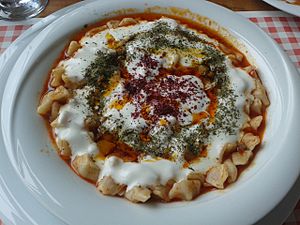Chili oil facts for kids
 |
|
| Alternative names | Hot chili oil, hot oil |
|---|---|
| Type | Dip |
| Main ingredients | Vegetable oil, chili peppers |
| Chili oil | |||||||
|---|---|---|---|---|---|---|---|
| Chinese name | |||||||
| Traditional Chinese | 辣油, 紅椒油, 紅油, 辣椒油, 紅辣椒油, 油潑辣子 | ||||||
| Simplified Chinese | 辣油, 红椒油, 红油, 辣椒油, 红辣椒油, 油泼辣子 | ||||||
|
|||||||
| Vietnamese name | |||||||
| Vietnamese | ớt sa tế, ớt satế | ||||||
| Thai name | |||||||
| Thai | น้ำมันพริก | ||||||
| RTGS | nam man phrik | ||||||
| Korean name | |||||||
| Hangul | 고추기름 | ||||||
|
|||||||
| Japanese name | |||||||
| Kanji | ラー油, 辣油 | ||||||
|
|||||||
Chili oil is a special kind of oil used to add flavor to food. It's made by mixing vegetable oil with chili peppers. This gives the oil a spicy kick! Different types of oil and peppers are used. Sometimes, other ingredients are added too.
This spicy oil is very popular in Chinese cuisine. You'll also find it in Southeast Asian food. It's especially loved in western China. Areas like Sichuan, Hunan, Guizhou, and Shaanxi use it a lot. People add it to cooked dishes. They also use it as a dip for meat or dim sum. In Korea, it's used in a noodle soup called jjamppong.
Chili oil usually has a red color. It's often made with soybean oil or sesame oil. But you can also use olive oil or other oils. Other spices like Sichuan pepper, garlic, or paprika might be added. Some store-bought chili oils have water, dried garlic, soy sauce, and sugar. You can even make it at home with oils like rapeseed or grapeseed. Any dried or fresh chili peppers work well.
The solid bits in chili oil usually sink to the bottom. When you use it, you can choose how many solids to add. Sometimes, people just use the oil without the bits. Chili oil is easy to make at home. You can also buy it in jars or bottles from stores.
Contents
Different Kinds of Chili Oil
Chili Oil in China
Chili oil has many names in China. It also comes in different types. These types depend on the region where it's made. In Shaanxi province, it's called yóu pō là zǐ. This means "chili pepper splashed with oil." In Sichuan, it's known as là yóu (spicy oil) or hóng yóu (red oil). The most common name is là jiāo yóu, which means "chili pepper oil."
In China, chili oil is made by pouring hot vegetable oil over chili pepper powder. Sometimes, chopped chili peppers are used instead. Many other ingredients can be added for more flavor. These include Chinese black vinegar, minced garlic, and sesame seeds. Spices like Sichuan peppercorn, cinnamon, and star anise are also popular. The famous chili oil brand Lao Gan Ma comes from Guizhou. There are also other sauces made from chili oil. One example is chili oil mixed with douchi (fermented black soybeans).
Chili Oil in Japan

In Japan, the Chinese style of chili oil is called rāyu. People use it for cooking or as a condiment. It's usually a clear, chili-flavored sesame oil. The chili peppers used are red, which gives the oil a reddish color. Other ingredients might include soy oil, corn oil, and ginger. Paprika and turmeric can also be added.
A new type of rāyu came out in 2009. It's called taberu rāyu, which means "rāyu for eating." This kind is less spicy. It has chunks of fried garlic and fried onion in the oil.
Chili Oil in Italy
The Italian version of chili oil is called olio di peperoncino. It comes from the southern region of Calabria. This oil is often added to dishes, sauces, and salads. It's also served with cheeses and appetizers. This Italian chili oil uses olive oil as its base. It has a special salty flavor. The peperoncino (chili pepper) is a very popular food in Calabria.
Chili Oil in Portugal
Portuguese chili oil is made in a different way. Dried red chili peppers are put into olive oil. This is done in a tightly sealed bottle. The bottle is kept cold for one month. This method is called cold infusion.
Chili Oil in Turkey

Chili and pepper-infused oils are widely used in Turkish cuisine. A Turkish dumpling called mantı is served with chili oil. This oil is poured over a garlic yogurt sauce. The oil is made by mixing chili paste (biber salçası) with spices. These spices include black pepper, chili flakes, dried mint, and cumin.
Another Turkish dish uses strained yogurt. This yogurt is topped with hot oil infused with dried chili peppers. This dish is called atom in Turkish. It is usually served as a meze, which is a small appetizer.
See also
 In Spanish: Aceite picante para niños
In Spanish: Aceite picante para niños

